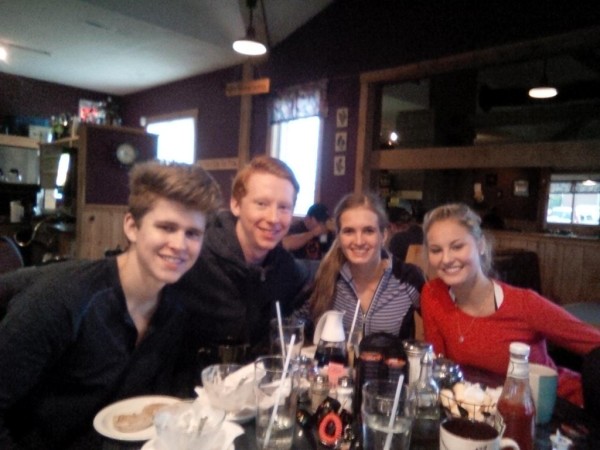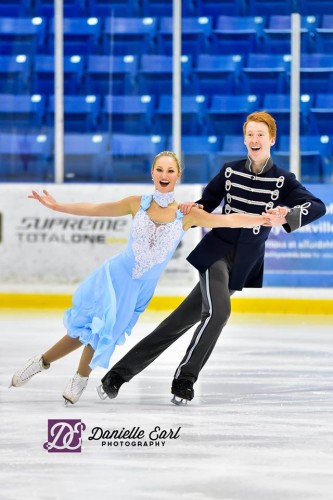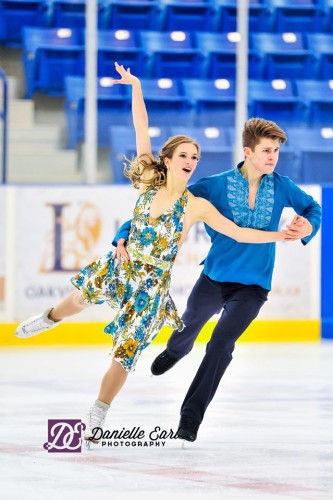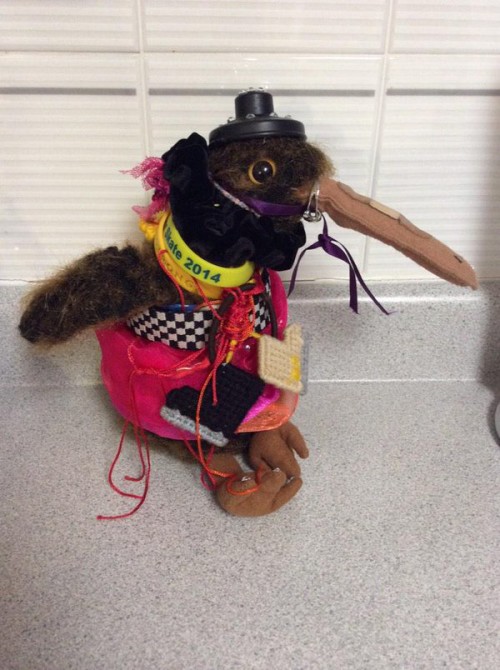by Jacquelyn Thayer
This week, senior dance at the Canadian Tire National Skating Championships will include a pair of training mates with a history of their own. In 2012, Mariposa School of Skating’s Lauren Collins and Danny Seymour became Canada’s novice ice dance champions. Four years later, the skaters will make their national senior debuts — Collins with Shane Firus and Seymour with Jocelyn Leblanc.

Firus, Seymour, Collins and Leblanc enjoy a mid-training breakfast. (Photo from Mariposa Dance on Twitter.)
After challenges within the junior ranks, Collins and Seymour split amicably following the 2013-14 season. Collins soon teamed with Firus, a junior medalist in 2013 with Caelen Dalmer, and achievement came quickly despite injury issues for Collins. Silver in the junior event at the 2015 Canadian championships earned the team additional consideration from Skate Canada for their entry to the senior ranks — an assignment to Nebelhorn Trophy in the ISU’s Challenger Series. The trip was a considerable success for a couple whose only previous international was a single Junior Grand Prix event; the two outdid their prior best total by 23.84 points and picked up a fifth-place finish within a more experienced roster, which included Mariposa alumni Alexandra Paul and Mitch Islam.
“Our first senior international was so much fun and a great experience,” they agreed. “We wanted to be aggressive in both skates and have an impressive first showing. We felt like we accomplished this and we were very happy with how we skated.”
After Nebelhorn came a slate of domestic qualifying events, including Central Ontario Sectionals and Skate Canada Challenge, where two strong skates led the team to silver in a field of more established dancers.
“We’ve been really trying to carry the momentum we got at Nebelhorn Trophy forward and pushing ourselves to do even better each time we go out to compete,” they said. “Challenge was an exciting competition for us because of the tough competition there. We wanted to pay close attention to levels on all elements, but in particular footworks in both programs.”
For Leblanc and Seymour, who teamed up in December 2014, the season has been one of development. “We both found ourselves without partners, started to gel, and decided to skate together officially,” said Seymour of their initial pairing. “We really enjoy skating with each other, and although we have had a slow start, we are really starting to come together and have received some very positive feedback regarding our ‘look’ as a senior team.”

Leblanc and Seymour skate their short dance at 2015 Skate Canada Central Ontario Sectionals. Photo by Danielle Earl Photography.
Injury and ailment have introduced some disruptions to the process, beginning with a concussion for Seymour in late June and stomach woes for Leblanc, along with more recent head injury for the latter. A spill in the short dance at Challenge dropped the team’s placement there, though a clean skate in the free dance better showcased their ability, and the two finished eighth overall.
With this week’s championships, both couples are setting their eyes on performance goals.
Collins and Firus, aiming for a top six placement, are gearing up for their first match-up against a few of Canada’s top-ranked teams. “Our mentality is to skate big and aggressive to compete with those other well-known senior teams,” they said.
Leblanc and Seymour remain focused on team progress. “Our goals as far as Nationals is concerned are to achieve personal bests,” said Seymour. “Recently training has been a little slow due to injury, but we have managed very well and know we are capable of out-performing our season’s best.”
Fostering each team’s goals are a set of programs aimed at highlighting strengths and pushing growth. Over the past several seasons, students at the Barrie, Ontario-based rink have developed programs with major outside choreographers as well as in-house coach and choreographer Kelly Johnson. This off-season, both senior couples worked with Shae Zukiwsky, who choreographed Collins and Firus’s “Beautiful Tango” free dance and built the base for Leblanc and Seymour’s short dance to selections from Prokofiev’s Cinderella. Romain Haguenauer tackled the former’s classical waltz to Strauss and Shostakovich, while Johnson created the latter’s free — depicting, in Seymour’s words, “a romantic struggle/conflicted relationship” — and contributed to their short.

Collins and Firus skate their free dance at 2015 Skate Canada Central Ontario Sectionals. Photo by Danielle Earl Photography.
For Collins and Firus, whose programs suit the personal style they describe as “traditional skating quality with a more contemporary twist,” the focus this autumn has been on additional training of Ravensburger key points and tweaking of the free dance’s final “Breakfast in Baghdad” section to help it “perform bigger” — including a switch from choreographic twizzles to a choreographic spin.
“The most difficult part of the free dance has been to show a different emotion in each piece and to tie that into the story and characters we are trying to portray,” they agreed. “The most natural part of these programs has been the actual skating aspects of it, whether it be gaining speed or using our edges to the fullest. The larger qualities that we have had to work on are fluidity of movement and making sure each movement has meaning” — concerns, they note, which take on greater significance at the senior level.
And with no prior experience for either partner at senior — Seymour concluded his junior career in a brief 2014 pairing with Yasmeen Jong — Leblanc and Seymour are making their own efforts to establish a more mature skating presence.
“One of the challenges we both faced is breaking some bad habits in our skating to start to look like a senior team,” he said. “The easiest part about coming together as a team was definitely our personal relationship — we were good friends before we were a dance team and skating together has brought us even closer. We both enjoy each other’s company which makes skating together that much easier.”
The two teams are Mariposa’s only current senior representatives, though the school also includes promising juniors and younger skaters. It’s a school, too, from which some past seniors have relocated in search of a more internationally-focused training environment. But with its emphases on strong basics and refinement and its division of focuses — with lead coach David Islam specializing in the technical, Johnson in artistry and James Callan in skating skill — the couples consider themselves in good hands.
“Mariposa is a competitive training environment with coaches that put in a lot of extra effort,” said Firus, who highlighted the differences between his new base and his former training site at Vancouver. “At Mariposa, much more attention is given to quality over quantity. Training in BC was also a very competitive environment, but repetition was a main focus there.”

Cow, Mariposa’s team mascot. (Photo from Mariposa Dance on Twitter.)
And the long-time students noted the developments they’ve seen over the seasons. “The training environment has seen lots of changes through the years and even within this year,” said Seymour. “Overall, this year I think Mariposa has a strong group of dancers and those dancers are all good people. We all bring something different to the table as far as our characters go, but it makes for a fun yet competitive environment.”
But one bit of consistency through years of change has been a special guest in attendance at student events: a stuffed bird named Cow, sometimes alternating as necessary with a smaller companion named MiniMoo.
“I don’t know the story, I just squeeze the beak,” said relative newcomer Firus.
“Ever since I began dancing I’ve been squeezing his beak for good luck before competing,” explained Collins. “We dress him with pieces of our costumes after each season. Cow made his first appearance in 2000 when the team felt they needed a team mascot. They were looking for a cow but settled for a Kiwi bird instead.”
And that sense of continuity is one that adds something more for the school’s long-tenured students.
“The dynamics at Mariposa have really changed for me over the years,” said Collins. “When I was younger and skating with Danny, we were one of the baby teams and looked up to the older dancers. We learned a lot from watching and being on the ice with these older leaders/role models. Now I am one of the leaders at the club — Shane and I are one of the older, more experienced teams that the next generation of young dancers at the club look up to and learn from.”
